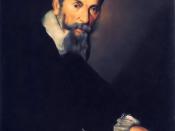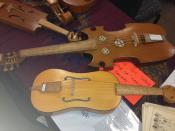Renaissance Genre
Renaissance music is European music created during the Renaissance times. Characteristics of the Renaissance music were gradually adopted, so it is difficult to define the exact beginning dates for this genre. Musicologists have placed its beginnings from as early as 1300 to as late as the 1470s. Middle Renaissance dates 1467 to 1543 and ending with Late Renaissance dating 1534 to 1600. This genre introduced different styles and trends to the musical world that were critical to the uniqueness of this paramount musical era. Musical instruments played a very critical role in the Renaissance genre. There were many instruments originated during the Renaissance while others were improved. Instrument families ranged from brass, strings percussion and woodwinds which will all be discussed further, as well as the many talented composers within this era.
Renaissance music (stile antico) was so rigid and structured and learned by academic training. The new concept (stile moderno) was a vehicle of spontaneous expression.
Both practices existed side by side. Some composers used both styles; stile antico in church music and stile moderno in secular vocal music. The Renaissance (which literally means "rebirth") was a time of great cultural awakening and a flowering of the arts, letters, and sciences throughout Europe. With the rise of humanism, sacred music began for the first time to break free of the confines of the Church, and a school of composers trained in the Netherlands mastered the art of polyphony in their settings of sacred music. Secular music thrived during this period, and instrumental and dance music was performed in abundance, if not always written down.
The increasing reliance on the interval of the third as a consonance is one of the most pronounced features of early Renaissance European art music. This differs from the Middle Ages, thirds had been considered dissonances. Polyphony, in use since the 12th century, became increasingly elaborate with highly independent voices throughout the 14th century. The beginning of the 15th century showed simplification, with the voices often striving for smoothness. This was possible because of a greatly increased vocal range in music - in the Middle Ages, the narrow range made necessary frequent crossing of parts, thus requiring a greater contrast between them. The modal (as opposed to tonal) characteristics of Renaissance music began to break down towards the end of the period with the increased use of root motions of fifths. This later developed into one of the defining characteristics of tonality.
Early Renaissance music (1400-1467) gradually dropped the late Medieval period's complex devices of isorhythm and extreme syncopation. Dropping these complex devices resulted in a more limpid and flowing style. Their music then lost rhythmic complexity, but gained in rhythmic vitality. A "drive to the cadence" became a leading element around mid-century. Transferring an image with a mechanical device by applying pressure to an inked surface resting upon a medium (such as paper or cloth) is called a paper press. This mechanical system was first assembled in Germany. This was introduced to the Renaissance era during the Middle period and had a huge effect on how music spread. A printed piece of music reached a much larger audience and it achieved this at a smaller cost. A tradition of famous makers began for many instruments during the Middle Renaissance music era. These makers were masters of their craft, which I will cover more extensively in the next few paragraphs.
Exploration, Scientific inquiry, and artistic awakening, and secularization were all an important role in the Renaissance era. Writers and artists found creativity and inspiration through the unique ways of ancient Greece and Rome. Musicians were employed in churches, cities, and courts or in the trades of instrument building and music printing. This was a time of a cappella singing with a fuller, more consonant sound. Compared to Medieval music, Renaissance carried a sound with more thirds and sixths and some pieces were built on a fixed, preexisting melody called cantus firmus while others closely reflected the text in music known as word painting. They did this to build a much more pleasing sound to their audiences. By implementing word paint into their pieces, musicians were able to reflect the meaning of words. This was very popular in secular music. By using a harsh dissonance or an ascending line the musician was able to reflect a dark or uplifting effect for the audience. This affected the listeners in a personal way. They were able to relate to the music and feel emotion as well.
During the Renaissance period many talented musicians emerged within society. Musicians were supported by the chief institutions, the church, city, and state. Aristocratic courts were also a big supporting role in society in this era. This made employment a possibility for many of these talented musicians. Most found employment through different roles such as choirmasters, singers, organists, instrumentalists, copyists, composers, teachers, instrument builders, and music printers. This brought a corresponding growth in supporting musical institutions such as church choirs and schools, music publishing houses, and civic wind bands. There were also a few women that can be credited as professional musicians during this era, usually earning wages as court instrumentalists and singers.
Claudio Monteverdi is one of the well known musicians that came about in the Renaissance period. Claudio was an Italian gambist (viola da gamba ), composer, and singer and his work was regarded as revolutionary. He marked the transition from the Renaissance style of music to the Baroque period. Two different styles of composition were developed by Monteverdi, the new basso continuo technique and the heritage of Renaissance polyphony. He is responsible for the creation of one of the earliest operas, L'Orfeo, which is still performed regularly today. Monteverdi mainly worked on madrigals and finalized his collection of works with nine books. One of the books in his collection was called the Ottavo Libro, the Eighth Madrigal Book. It was considered the perfect form of the madrigal and it is the largest of all his books.
The Renaissance was a very paramount time period in the development of humanity and society because of the significant adjustments in music, exploration, the Church, art, and writing. In the medieval period, the society had fallen into a deep slumber. Significant amounts of people decided to adhere to ideas that were thought up by blind thinkers. The Renaissance was an awakening to reality. Also referred to as the period of rebirth, it showed the sparkling brilliance of how musicians were a huge part in the advancement of artistic creations within music.
Works Cited
Forney, Kristine and Machlis, Joseph. The Enjoyment of Music. NY: W.W. Norton & Company, 2007.
Wikipedia contributors. "Renaissance music." Wikipedia, The Free Encyclopedia. Wikipedia, The Free
Encyclopedia, 19 Feb. 2010.
http://en.wikipedia.org/wiki/Renaissance_music#Style_and_trends
Wikipedia contributors. "Printing press." Wikipedia, The Free Encyclopedia. Wikipedia, The Free
Encyclopedia, 28 Feb. 2010.
http://en.wikipedia.org/w/index.php?title=Printing_press&oldid=346878285
Wikipedia contributors. " Claudio Monteverdi." Wikipedia, The Free Encyclopedia. Wikipedia, The Free
Encyclopedia, 4 March. 2010.
http://en.wikipedia.org/w/index.php?title=Printing_press&oldid=346878285


